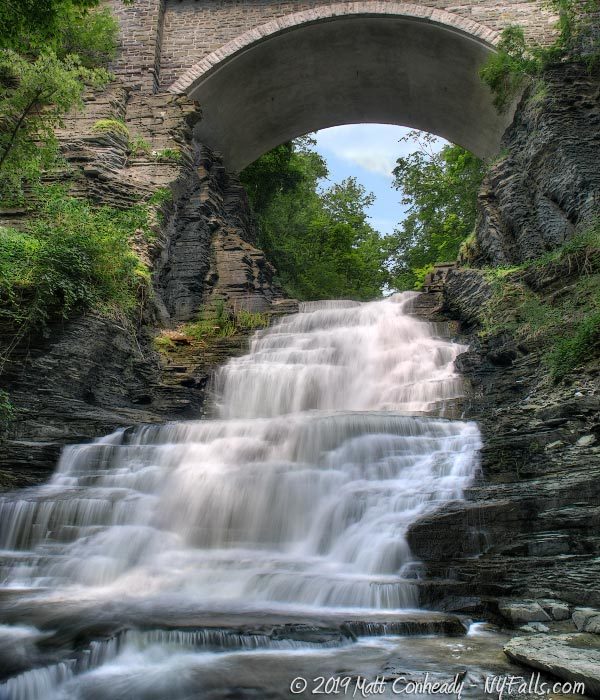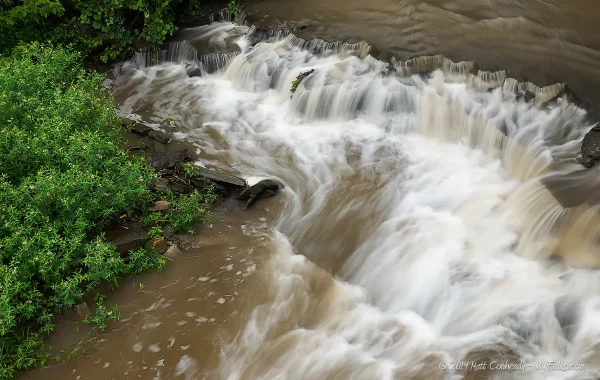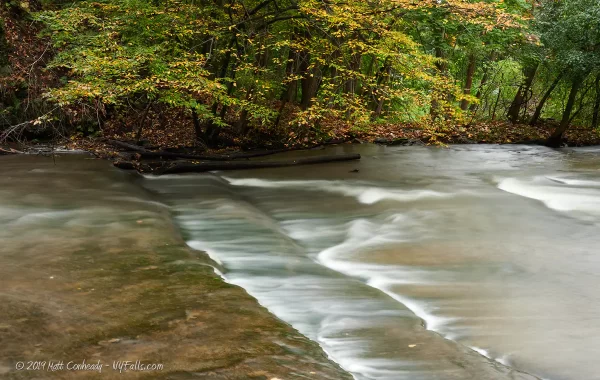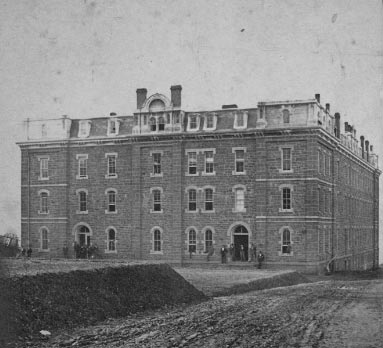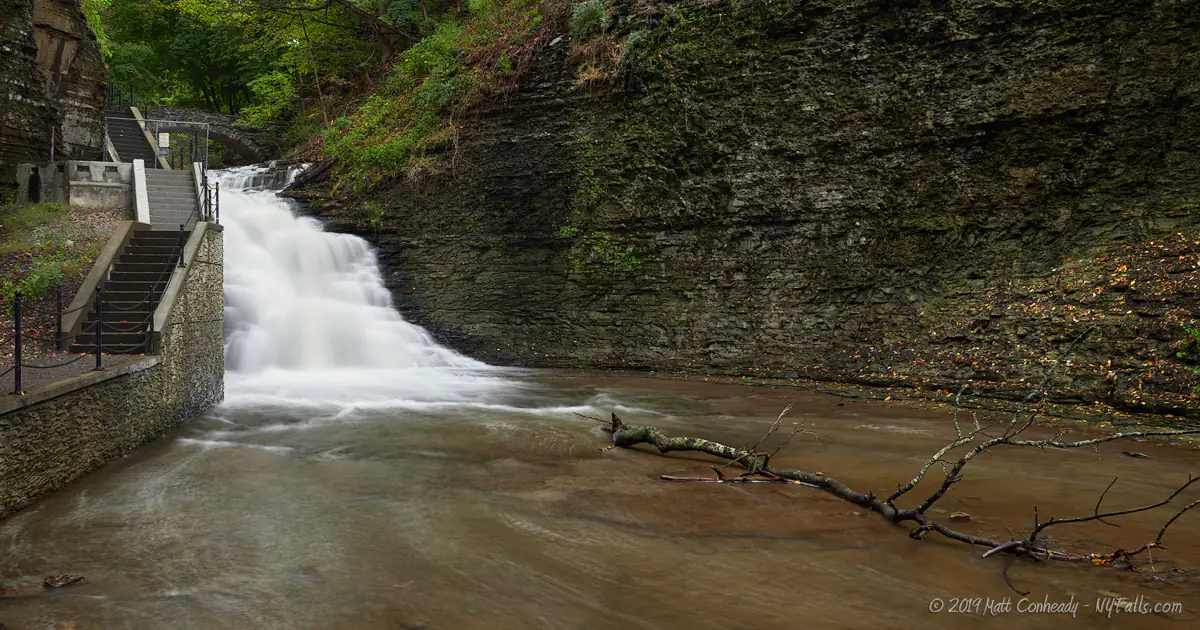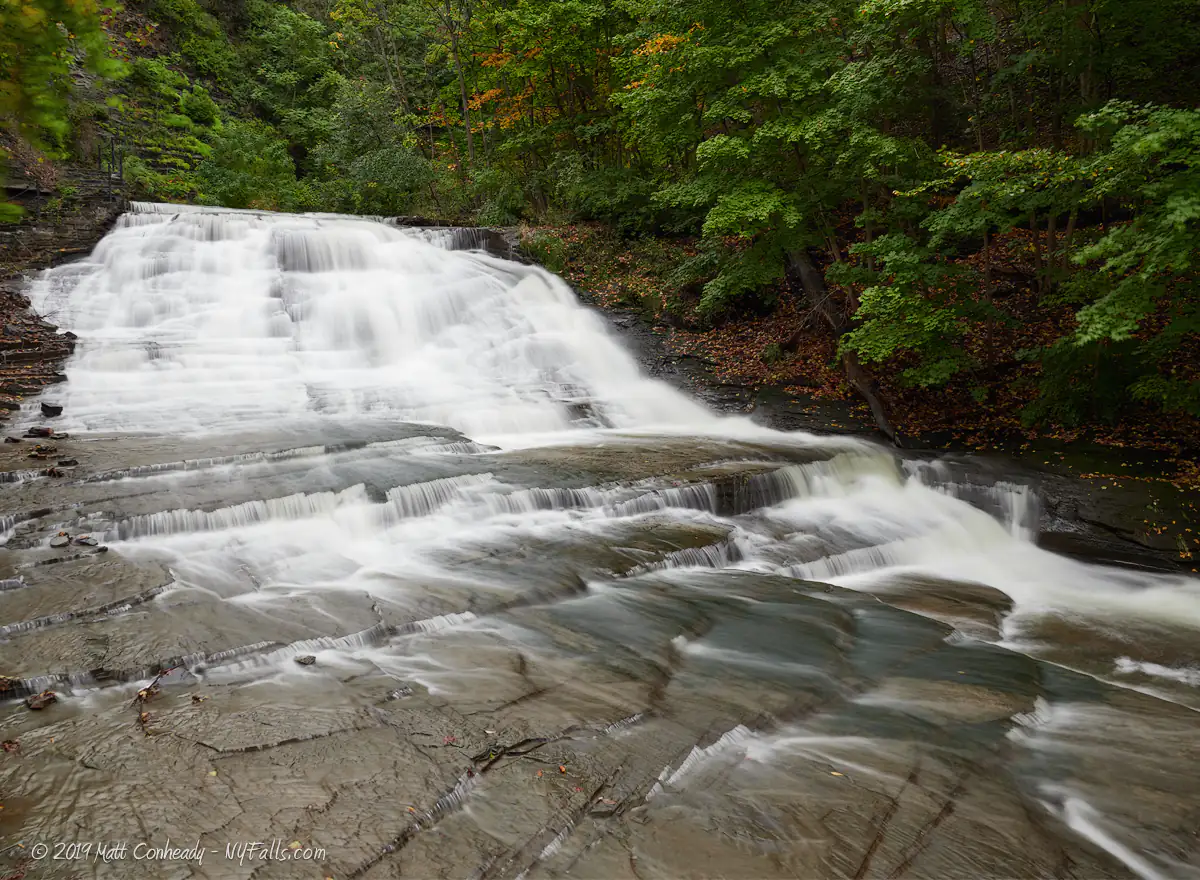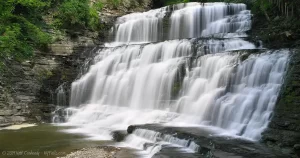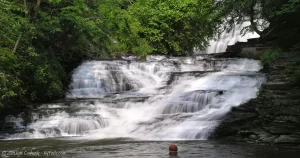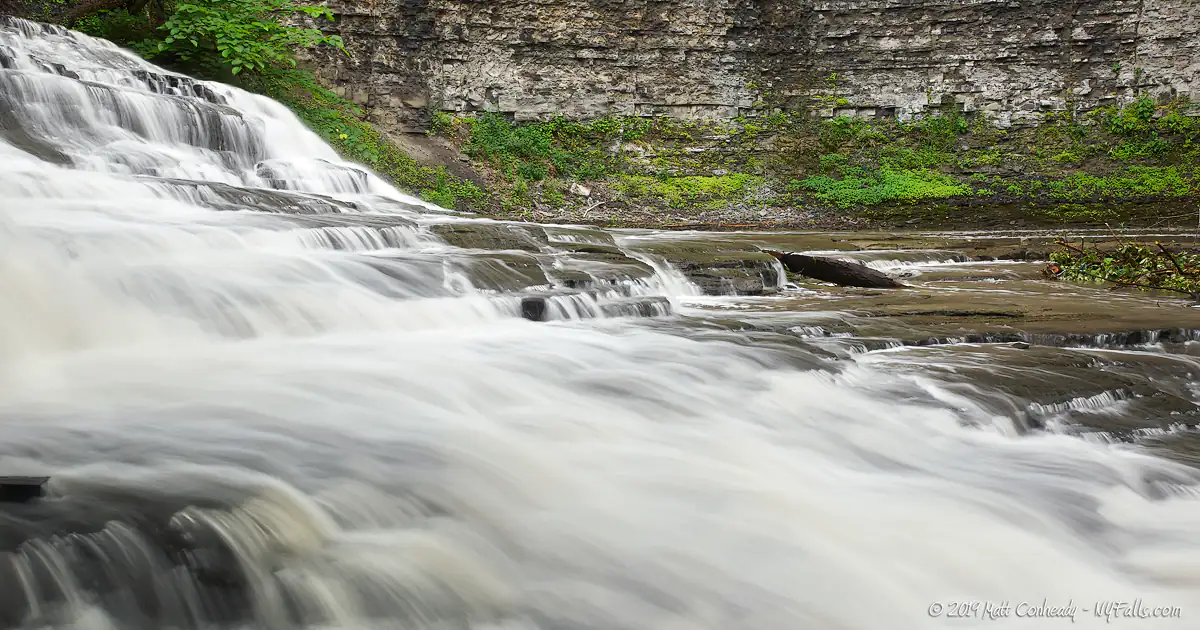Cascadilla Gorge
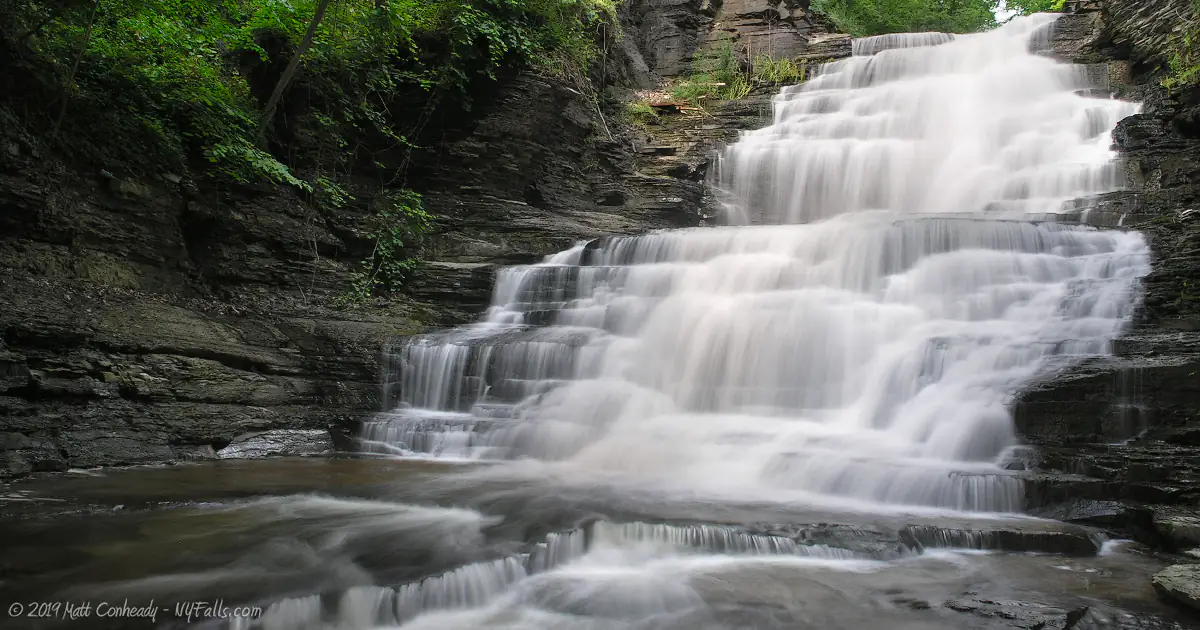
Location: Cornell University Campus; Ithaca; Tompkins County; Finger Lakes Region; New York.
Maps: Google Map; Topographic; Trail Map; Interactive.
GPS: West Entrance: (N 42.44302 / W 76.49411)
East end at College Ave: (N 42.44324 / W 76.48519)
Directions: Located just south of Cornell University in the city of Ithaca, on the south end of Cayuga Lake. Park alongside E. Court Street, which is off of N Cayuga St. Then head east toward Linn St. and start heading north (left). The entrance will be on your right (look for a small community park).
Google Maps to the corner of E Court and Linn St.
Parking: You have several options. First choice is the small roadside lot off of Linn Street. Second choice is roadside parking near the entrance off of Linn. There’s also roadside parking alongside Oak Ave (near where it intersects with College Ave) half-way up the gorge on the south end. There’s a trailhead near this lot. There’s a larger lot off of Hoy Rd deeper into campus and at the west end of the gorge trail.
Check the interactive map for locations.

Weather
Information / Accessibility / Accommodations
Number of falls: 8 waterfalls (6 of which are significant in size).
Size/Types: Frothy cascades down shale and limestone. From small drops to wide cascades, some reaching 54 ft high, with sizable plunge pools below.
Best time to visit: Spring through fall.
Flow: Moderate; though it does tend to dry in summer. It does become quite a torrent during rain.
Waterway: Cascadilla Creek, a tributary to the Cayuga Inlet, which empties into Cayuga Lake.
Time: 30 minutes to an hour. More if you are photographing.
Seasons/Hours: Open daylight hours. April through November or first freeze. The trail is highly dangerous when icy. The trail is often closed for repairs as well. Please observe and respect the “Posted Trail Closed” signage and do not proceed if closed.
Admission: Free. Parking may be metered. It depends on what street you settle on.
Handicap accessibility: To the grassy park off of Linn St , and to a decent view of the first falls, but not up into the gorge.
Pets: Seemingly allowed (with leash, obviously). For their safety and the safety of others, we recommend you do not take your pet on any gorge trail. Dogs aren’t good climbers, shale is sharp, and they could unwittingly bump someone to their death. Just be responsible.
Swimming: Not allowed. Swimming in the gorge is prohibited and the area is often patrolled by campus police. The currents in Ithaca gorges are extremely dangerous.
Accommodations: Trail; informational signage.
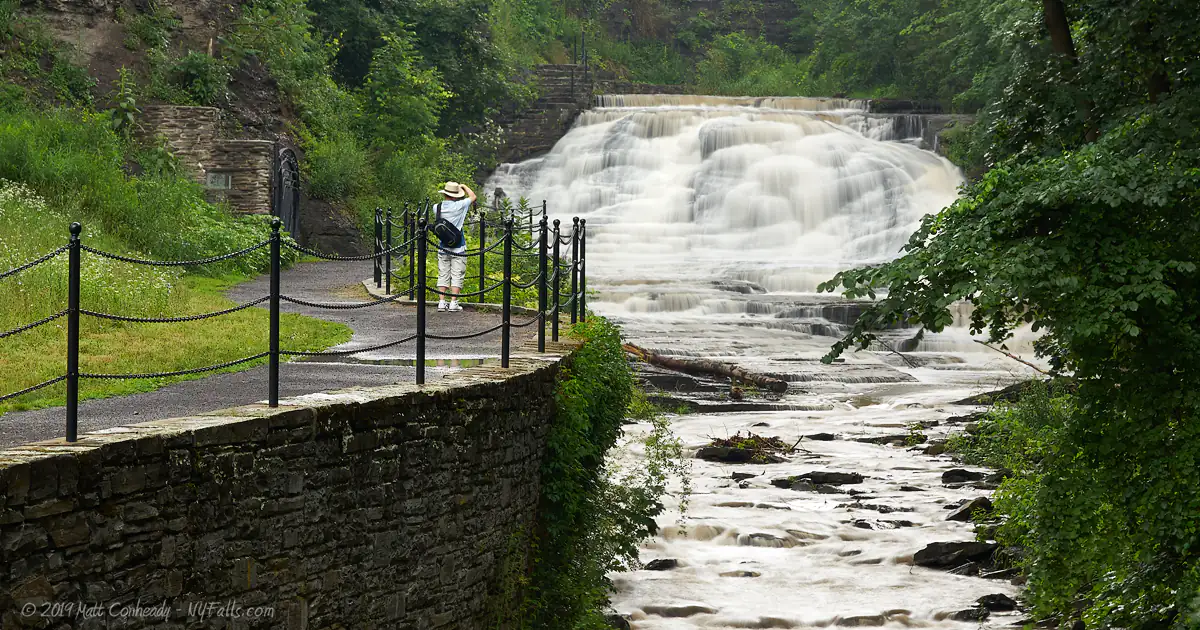
Description
Cascadilla Gorge is a popular trail connecting the Cornell University campus to Collegetown, a district of Ithaca south of the campus. It is often used by students as a shortcut between the two. So widely used, it is often referred to as “the staircase,” both for the tumbling step-like cascades and for the grueling climb as you ascend the trail to campus.
Although packed with development on both the north and south rims, you would probably not realize this while walking the trail. The gorge is deep and narrow, hiding you from the busy city above and providing this glen a natural serenity. Just as they did with Watkins and Fillmore Glen parks, the Civilian Conservation Corps originally constructed the stone pathways and bridges that wind through the gorge, crossing the creek when necessary, and ascending the towering waterfalls. Most of that work has since been replaced with recent repairs.
The gorge drops over 400 feet from Cornell campus to downtown Ithaca, carving through layers of shale and sandstone. There are multiple waterfalls here with six sizable ones. As you make your way up the trail, each cascade seems to roar louder than the next. The many overhangs and soft shale cliffs pose a slight danger as large stones fall often in spring, with small stones falling every few minutes. The small crackles and pops you’ll hear when deep in the gorge are a constant reminder that it is ever-changing. Often massive rock slides will destroy portions of the trail, forcing closure for repairs. Usually this happens in the winter as water seeps into the cracks in the rocks, freezes and expands, prying apart the stone. For several years large portions of the gorge were closed down for repairs.
The trail begins in a small community park, with plenty of visible sunlight in downtown Ithaca and ends in a damp, botanically-rich narrow section of the gorge below the Cornell Center for Theater Arts. Several small pools and dry banks along the way give students and area residents an opportunity to read a book in the shade or dip in the refreshing water.
Due to the high frequency of recreational use, as well as the near 100% development of the surrounding area, the fragility of the Cascadilla Creek ecosystem is a strong concern. The gorge has an array of unique micro-ecosystems spread throughout the different elevations and within different moisture and sun-exposed portions. Constant disruption from visitors and polluted run-off from the city above threaten their stability. Cornell Plantations, which manages the gardens and natural space around the University, cares for the gorge and is committed to maintaining it for public enjoyment.
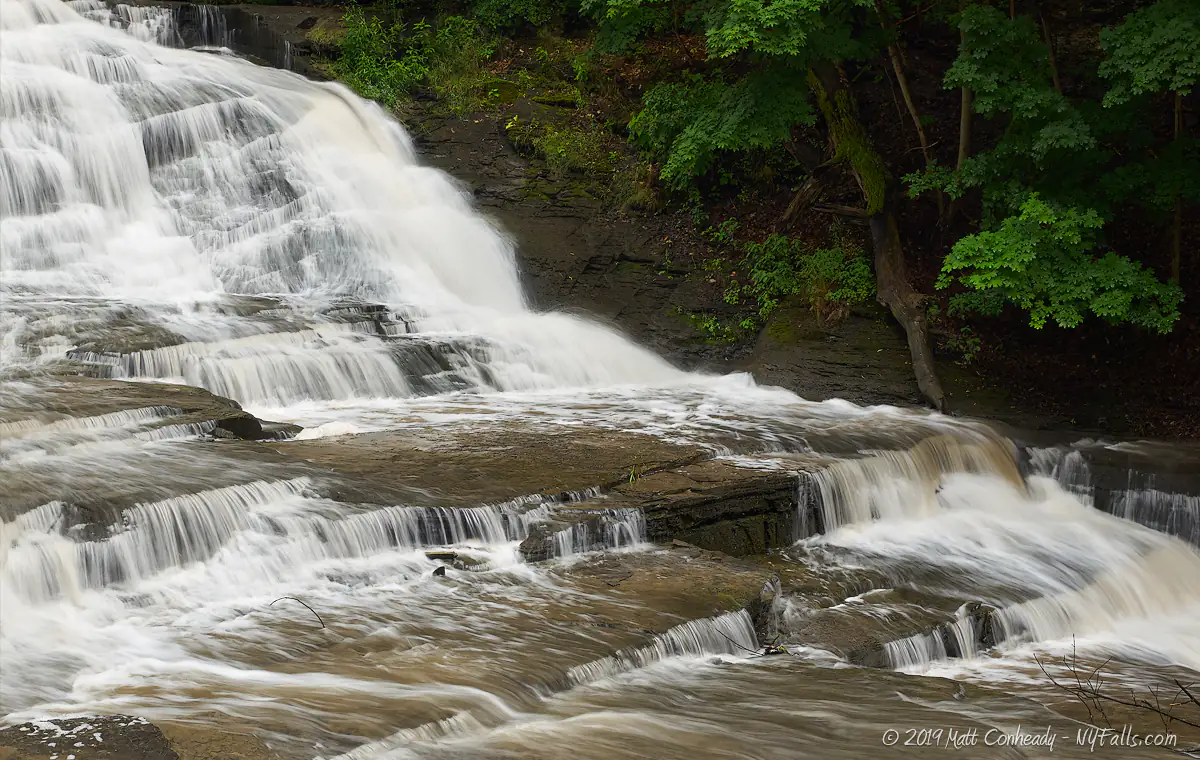
History
The Yaple family was among some of the first settlers of the town in 1788. John Yaple built a grist mill on the creek on East Hill. Peter Hinepaw built a mill on the west end near Linn St.
Once used as a stone quarry, the gorge has changed drastically from its natural state. Some of the surrounding buildings rest upon foundations from Cascadilla-harvested rock.
Where the campus is today, Cascadilla Place was constructed in 1859 as a “water cure” facility. Water was diverted from the creek and ran through the large building for “therapeutic” purposes, as was the fad at the time. The building was very influential in the choosing of the location for the university, which took over the structure and renamed it Cascadilla Hall. At least one more mill operated upstream from here.
The book “Landmarks of Tompkins County, New York: Including a History of Cornell University” edited by John H. Selkreg, describes an account of a Professor’s commute from the city to the west to the fledgling university in the 1860s:
To reach the university it was necessary to climb a hill without sidewalks; to skirt Cascadilla, passing an old weather-stained mill which stood behind it, and avoid skillfully the debris around the buildings; to descend into a gorge by ladders, and to risk one’s life in crossing planks; to wind through the woods upon the north bank, and then pass through fields and over two successive ravines, and climb over fences, before the solitary building which constitutes the university is reached.
In 1909, Cornell alumnus and trustee Robert H. Treman gave Cascadilla gorge to Cornell University to maintain for public education and enjoyment.
The origin of name Cascadilla is unknown, but it may be from the Spanish word for “little cascades.”
Hiking / Walking Trails
Difficulty: Gets progressively more difficult. There are a lot of steps to climb.
Markings: Just the stone walkway.
Distance: 7,800 ft one way.
Trail Guide:
- From Treman Triangle Park off of Linn St, follow the path upstream. You first pass a 20 ft cascade on the right, then a gradual cascade that curves around a bend. Note the island in the center of this one.
- An 11 ft cascade is up ahead and then a narrow 22-footer called Stewart Falls. A stone CCC bridge will take you across the creek.
- Continue up the path past the next 20 ft cascade, the wide 35 ft Lower Falls and finally you’ll end up at the 50 ft Upper Falls (also known as Cascadilla Falls or Giant’s Staircase) just below College Ave.
- Continue to the steps that lead to the Cornell campus. You can turn around to go back or cut through the campus and streets to get back.
- The creek and trail extend beyond College Ave, but there’s little in the way of waterfalls. Climb the steps to the Cornell Campus, cross College Ave and head back down into the gorge to continue.
Map: Trail Map; Interactive.
Cascadilla Gorge Interactive Map
Cascadilla Falls Media
Cascadilla Falls Videos
More coming soon…
Cascadilla Falls Photo Gallery
Interesting Stuff
Fossils
The rock that comprises the gorge is a great source of brachiopod fossils.
De Witt
Simeon De Witt, Geographer and Surveyor General of the Continental Army during the American Revolution, worked as the Surveyor General of New York, from 1829 until his death in 1834. He was responsible for many of the classical Greek and Roman names given to places in Upstate New York. He died from a cold while visiting his properties in Ithaca, and was buried within the gorge. His grave was since moved to Albany Rural Cemetery.
Rock piles
Throughout the trek, you may notice artistic stacks of stones called cairns. Although they look mysterious, they are built by visitors. It’s a form of public art. Feel free to make one while you are there.
Photography Tips
Prepare
- The sheer number of waterfalls in this gorge coupled with the millions of composition possibilities means you could spend a full day photographing. Plan on getting there early and bring a variety of lenses. Get to know the park before shooting. You are going to want to spend most of your time at certain locations. You will find it very easy to get distracted along the way.
- Get to the gorge early to avoid the crowds.
A good tripod
- Make sure you have a versatile tripod as you may have to lean it up against rock platforms and bend it in unusual ways to get your shots.
Lighting
- Sunlight bursting through the canopy can ruin a pretty shot of the shadowy falls below, so it’s best to tackle this gorge on overcast days.
- Some areas of the gorge are dark enough so you won’t need a neutral density filter to get the silk effect.
Silky Water Effect
- To get that smooth cotton-candy look to the falls, you need to use a Neutral Density (ND) filter on your lens. The ND filter will block some of the light from entering the lens without altering the color, and thus allow your shutter to stay open longer. This blurs the water and creates a soft white gloss to the foamy areas of the falls. Check out the article for the all the details.
More tips
- See the Articles for more photography tips.
10 Must-Visit Waterfalls Around Ithaca, NY
A selection of the most popular and accessible waterfalls around Ithaca in the Finger Lakes Region of New York.
Who to Contact
Cornell Plantations
1 Plantations Road
Ithaca, NY, 14850
Phone: 607-255-2400
cornellbotanicgardens.org




